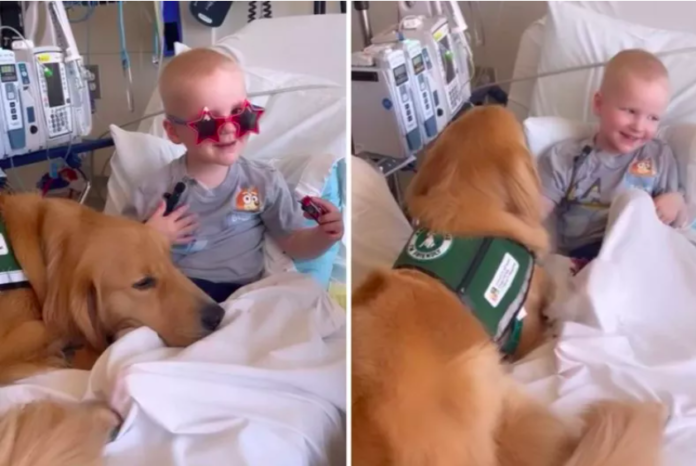Last Updated on June 10, 2024 by Fumipets
A heartwarming video featuring a 2-year-old cancer patient at the University of Iowa Stead Family Children’s Hospital and the hospital’s facility dog has melted hearts across the internet. The video demonstrates the incredible impact a dog’s presence can have, even during the most challenging times.
The Role of Facility Dogs in Pediatric Care
Meet Nacho and Corrin
The University of Iowa Stead Family Children’s Hospital introduced two facility dogs, Nacho and Corrin, to their team last year. These dogs work in a pediatric healthcare setting, providing vital patient care and promoting healing. Their activities are regularly highlighted on their Instagram account, @uichildrens_facilitydogs.
Promoting Recovery
The facility dogs play a crucial role in encouraging recovery among young patients. Their duties include:
- Walking with patients during physical therapy or after surgery.
- Decreasing fear and anxiety.
- Providing distraction and coping skills.
- Helping patients learn to take medicine.
- Offering emotional support.
The dogs are always accompanied by their handlers, who are full-time child life specialists at the hospital.
A Special Bond: Nacho and Mason
A Day with Nacho
A particularly touching Instagram video from May 19 showcases a day in the life of Nacho as he spends time with Mason, a 2-year-old cancer patient. Nacho and Mason have developed a strong bond since Nacho started working at the hospital.
Building Relationships
“They have a really good relationship, and Mason is always really excited to see Nacho,” said Emily Bradley, Nacho’s handler and a child life specialist. “I know that Nacho has become a part of his family’s life.”
A Heartwarming Session
During their latest session, Nacho and Mason enjoyed treats, pets, stylish glasses, and cars. Mason’s face lit up with a huge smile as Nacho sat with him on the bed. Nacho was equally happy, enjoying his fair share of goldfish treats.
The Impact of Facility Dogs
Emotional Support and Coping
Nacho and Bradley have spent considerable time with Mason during his appointments, teaching him how to swallow pills and providing coping support during fusion appointments. Mason’s family often shares how much their son loves looking at new photos and videos of Nacho and Corrin on Instagram.
Becoming Hospital Celebrities
Nacho and Corrin have become celebrities at the hospital, loved by both patients and staff. “He loves his job a lot,” Bradley noted. “I think he would rather be at work than at home on his off days… He loves all the attention.”
Philanthropic Support
The facility dogs are fully supported by philanthropic and donor dollars, covering their food, treats, vet bills, care, and grooming. The hospital hopes to eventually add a third facility dog, allowing for continuous coverage.
Public Reaction to the Viral Video
Social Media Buzz
The Instagram video of Nacho and Mason has touched many hearts, amassing over 6.6 million views and 409,417 likes. Comments from viewers highlight the emotional impact of the clip:
- “This is so precious and healing!” commented one user.
- “I could watch this on repeat forever. Love these two sooo much!” wrote another.
- “Goldens are fur-covered angels,” posted another user.
A Mother’s Gratitude
Mason’s mother also commented on the video: “Mason loves his time with Nacho!!! We will cherish this forever.”
Conclusion
The bond between Nacho and Mason is a beautiful reminder of the profound impact that animals can have on our lives, especially during challenging times. Facility dogs like Nacho and Corrin provide invaluable support and joy to young patients, making their hospital experience a little brighter.
Frequently Asked Questions (FAQs
1. What is the role of a facility dog in a hospital?
Facility dogs in hospitals provide emotional support, assist in physical therapy, help reduce anxiety and fear, and promote overall healing for patients.
2. How do facility dogs help in pediatric care?
Facility dogs help pediatric patients by offering comfort, companionship, and motivation during their recovery process. They assist in therapy sessions, help with coping mechanisms, and provide emotional support.
3. How are facility dogs funded?
Facility dogs are typically funded through philanthropic donations and donor support, which cover their food, treats, vet bills, care, and grooming.
4. Can facility dogs help with specific medical procedures?
Yes, facility dogs can help children learn to take medicine, offer distraction during medical procedures, and provide comfort and support during recovery.
5. How can I follow the activities of facility dogs like Nacho and Corrin?
You can follow the activities of Nacho and Corrin on their Instagram account, @uichildrens_facilitydogs, where regular updates and heartwarming stories are shared.
For more information, visit the original article on Newsweek.


















